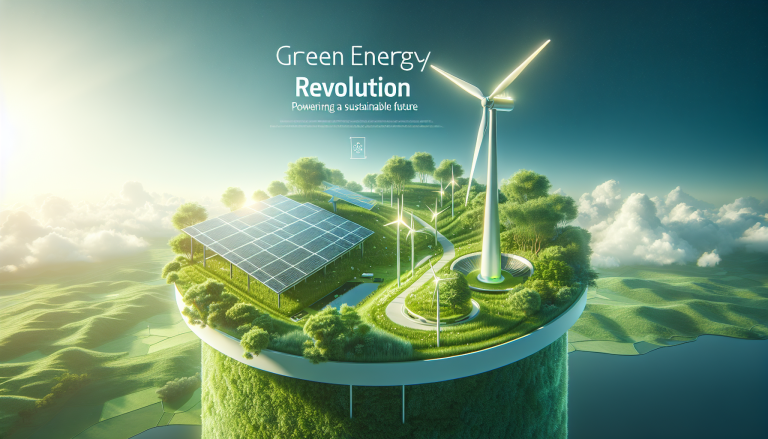The Ascendance of Green Energy: Transforming Our Environment
In recent years, the field of environmental science has taken a remarkable leap through advancements and innovations in green energy. This transformation is more than a trend; it represents a vital shift toward a sustainable future, underpinned by science and technology working hand in hand to preserve and enhance the environment. Green energy, which includes renewable sources such as solar, wind, hydro, and geothermal power, is rapidly becoming the cornerstone of global efforts to combat climate change and reduce environmental degradation.
The urgency stems from the fact that traditional fossil fuels emit greenhouse gases responsible for climate change, causing melting ice caps, extreme weather events, rising sea levels, and biodiversity loss. Environmental science has tirelessly focused on identifying cleaner alternatives, and green energy stands as a beacon of hope. Scientific advancements have enabled higher efficiency and cost reductions, turning what was once niche technology into mainstream power sources capable of meeting extensive energy demands.
Scientific Innovations Driving Green Energy Progress

Solar photovoltaic (PV) technology exemplifies progress in environmental science. Over the past decade, solar panel efficiency rates have soared beyond 25%, thanks to breakthroughs in materials science like perovskite cells. These materials promise even higher efficiencies and lower production costs, making solar energy increasingly accessible. Additionally, innovations such as bifacial solar panels that capture sunlight on both sides amplify energy yield from the same surface area, optimizing installation in urban environments where space is limited.
Wind energy, another pillar of green power, has also experienced rapid technological development. Modern turbines are taller, longer-bladed, and smarter, utilizing advanced sensors and AI algorithms to maximize energy capture even in low-wind conditions. Offshore wind farms, like the Hornsea Project in the UK, demonstrate the enormous potential for environmentally friendly energy from the ocean, capable of generating power sufficient for millions of homes without the direct emission of pollutants.
Energy storage has been a critical challenge historically hampering the integration of intermittent sources like solar and wind. Environmental scientists and engineers have made strides with battery technology, particularly lithium-ion and emerging solid-state batteries. Developments in grid-scale storage stabilize the supply, enabling green energy to offer reliable power regardless of weather or time of day. More innovative solutions, such as pumped hydroelectric storage and hydrogen fuel cells, complement these efforts by leveraging natural cycles and clean chemical energy storage.
Global Initiatives Catalyzing Green Energy Adoption
A pivotal example of the transformative power of environmental science is seen in global cooperative efforts. The European Green Deal, launched by the European Union (EU), exemplifies a comprehensive framework engaging science, technology, policy, and economics to achieve carbon neutrality by 2050. This initiative commits massive investments into renewable infrastructure, incentivizes cleaner transport, and targets energy efficiency upgrades in buildings. The result is a model that balances environmental integrity with economic growth, crafting a pathway many nations are keen to emulate.
Similarly, the International Solar Alliance, an alliance between over 120 countries, focuses on promoting solar energy in sun-rich developing nations. This initiative illustrates how knowledge-sharing and joint financing can revolutionize the energy landscape across diverse regions, empowering communities to leapfrog fossil fuel dependency and embrace clean power.
China’s ambitious move to become the world’s largest producer and consumer of solar panels highlights how national policy and environmental science can combine to reshape global energy markets. With over 300 GW of solar capacity, China demonstrates how integrating science-driven manufacturing and deployment strategies can produce scale and drive down costs worldwide.
Real-World Successes Illuminating the Path Forward
Concrete success stories underscore green energy’s transformative potential on the environment. Denmark derives nearly 50% of its electricity from wind power, with plans to exceed 75% in the next decade. These achievements have not only slashed the country’s carbon emissions dramatically but also fostered technological exports and local job creation—proving that environmental progress and economic vitality can advance hand-in-hand.
In the United States, the Tesla Gigafactory in Nevada showcases how large-scale production of lithium-ion batteries can accelerate the green energy transition. By supplying energy storage for both electric vehicles and renewable energy grids, Tesla supports the decarbonization of both transportation and electricity sectors, leading by example in corporate environmental responsibility.
Kenya’s Lake Turkana Wind Power Project further highlights how harnessing renewable energy fosters sustainable development in emerging economies. As Africa’s largest wind farm, it supplies power to 1 million homes, promoting energy access while reducing dependence on costly and polluting diesel generators, improving both climate and local livelihoods.
Challenges Along the Greener Road
Despite these successes, the green energy revolution faces serious hurdles. Integrating widely distributed renewable sources demands substantial upgrades to existing infrastructure. Grid modernization requires massive capital investments and coordination among multiple stakeholders. Environmental scientists are working alongside policymakers to ensure that such developments protect biodiversity and ecosystem services, avoiding unintended consequences such as habitat loss or water scarcity caused by poorly sited projects.
Sustainability of raw materials for clean energy technology, such as lithium, cobalt, and rare earth elements, presents another challenge. Extracting these metals can generate pollution and social conflict if not managed responsibly. Recycling technologies and the development of alternative materials are emerging solutions being actively explored, emphasizing that green energy must be circular and socially just to fulfill its promise to the environment.
Social acceptance is equally crucial. Communities sometimes resist renewable projects due to concerns over noise, visual impacts, or land rights. Addressing these concerns through transparent dialogue, fair compensation, and inclusive planning is vital for long-term success.
Expert Perspectives and Future Horizons
Environmental experts agree that green energy innovations must continue to rapidly evolve and scale to meet climate targets. “The transition to renewable energy is not just a necessity—it’s an opportunity to innovate, improve quality of life, and create sustainable economies,” remarks Dr. Lina Martinez, a leading environmental scientist specializing in energy systems. Emphasizing synergy between technology and policy, she highlights how increased investment in research, coupled with supportive regulations, can accelerate breakthroughs in areas like hydrogen fuel and artificial photosynthesis.
Looking ahead, integrating green energy into smart cities will further enhance sustainability. The convergence of environmental science with digital technologies—such as IoT, AI, and blockchain—promises optimized energy use, reduced waste, and enhanced resilience against climate impacts. Customizable microgrids and decentralized energy systems could empower communities to generate and manage their own power sustainably, fostering environmental stewardship at the grassroots level.
Environmental scientists are also investigating the interplay between green energy and natural ecosystems. Techniques like agrovoltaics, which combine agriculture and solar panels, aim to boost land-use efficiency while supporting biodiversity. Innovations in offshore energy generation seek to protect marine habitats even as power production increases.
Embracing the Green Energy Revolution
The surging significance of green energy within environmental science exemplifies the transformative power of knowledge, innovation, and collective action. As this revolution unfolds, it paves a hopeful path where humanity’s energy needs align harmoniously with the environment’s well-being. Real-world successes illuminate how science-driven green energy not only curbs climate change but also enriches communities and preserves the planet’s precious natural heritage. While challenges remain, rising expertise and global commitment signal that a clean, vibrant environmental future is within reach—one solar panel, one wind turbine, and one innovative idea at a time.


